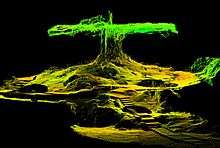Balankanche

Balancanché (Spanish: Grutas de Balancanché) are the most famous Maya cave sites, near Chichen Itza, in Mexico.[1] Other names of the cave include, Balancanche, Balaamcanche, Balaancanche, Balankanche and Balancanchyn. The name translates to "the cave of the sacred jaguar throne". According to Bruce Rogers, the name of the cave is related to the Mayan leaders, not the animal jaguar. For the past 22 years, the cave has been used as a tourist attraction.
History
Balancanché was known to the Mayans as early as the pre-classical period, 3,000 years ago. The cave was a source of water and because of this, was the object of worship to the god of rain, Chaac.
Discovery and study of caves
For the first time in modern times, Balancanché was visited by Edward Thompson and Alfred Tozzer in 1905. In different periods, the cave was studied by: A. Pearse and his team of biologists (1932 and 1936), E. Wyllys Andrews IV (1930), Edwin Shook and RE Smith of the Carnegie Institution (1954). In 1954, José Humberto Gómez found a walled-off passage in one of the branches of the cave. Behind it was a Maya sanctuary consisting of the "Altar of the Jaguar" and the "Altar of Pristine Waters." The cave ended at a small lake. The sanctuary has been studied and described by Ramon Pavon Abreu. It turned out that the sanctuary was built in honor of the god Tlaloc, and walled in about 842 AD during the Classic Maya collapse.
Gallery
Notes
- ↑ Стингл, Милослав. Тайны индейских пирамид. Москва: Прогресс, 1978.
References
- Bruce Rogers. Grutas de Balancanche. // AMCS Activities Newsletter No. 27 , May 2004. pp. 79–83.
- E. Wyllys Andrews IV. Balankanche, Throne of the Tiger Priest. Tulane University, 1970. ISBN 0-939238-36-5.
- Grutas de Balancanché / Balancanche Caves 24/ I /'10 on YouTube
External links






